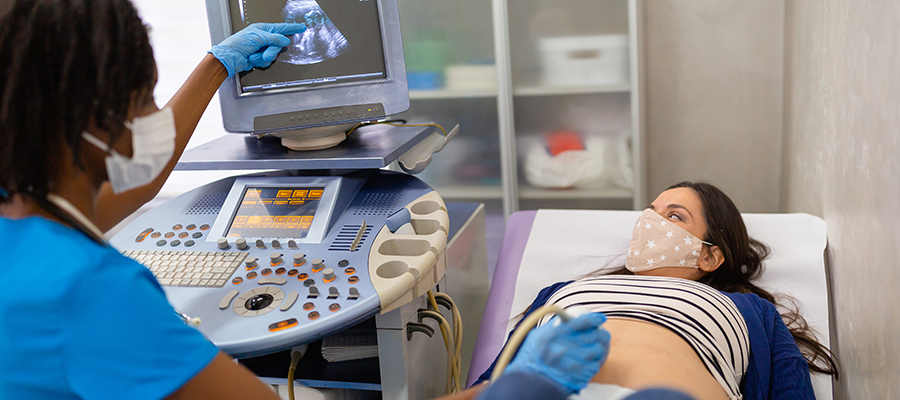
What is an ultrasound?
Ultrasound diagnostic imaging, also called sonography, is a non-invasive procedure that uses sound waves and a computer to create images of your soft tissue structures such as muscles, blood vessels and organs. Physicians use ultrasound to diagnose a number of conditions that may not be adequately assessed using other imaging methods such as X-ray, CT or MRI.
Ultrasound imaging is often used to:
-
examine the kidneys, liver, spleen, pancreas, gallbladder, female reproductive organs, breasts, muscles, tendons, prostate, heart and its valves
- viewing an unborn fetus
- assess blood vessels for clots and areas of narrowing
- monitor a developing fetus
- detect tumors or masses
- guide radiologists during minimally invasive biopsies and interventional therapies
- provide a 3-D or 4-D view of the body part being studied
How does ultrasound imaging work?
Ultrasound can be performed on an outpatient basis or as a part of inpatient care. The ultrasound machine includes a hand-held device, known as a transducer, and a computer, which is usually mounted on a rolling cart.
Unlike X-rays and CT scans, ultrasound does not use radiation. Here's how ultrasound works:
- The transducer emits ultrasonic sound waves, which are sounds at a frequency too high for humans to hear.
- When the ultrasound technologist places the transducer on the body, sound waves travel painlessly through the skin and other body tissues to the structures and organs within the body.
- The sound waves bounce off these internal structures, very much like an echo off of a canyon wall. Different structures affect the speed of the waves. The waves then return to the transducer.
- The speed of the waves is collected and sent to the computer, which assembles an electronic picture of the organs or tissues that are being studied.
- A radiologist (a board certified physician who specializes in reading images) creates a report and sends the information to your physician.
How to prepare for your ultrasound
- Wear comfortable, loose-fitting clothing.
- Depending on the type of ultrasound exam you have, you will be asked not to eat or drink for up to 12 hours before your appointment, or drink up to six glasses of water two hours prior to your exam and avoid urinating. This will ensure a full bladder when the exam begins.
What to expect during your ultrasound procedure
- Before you have any procedure, you should discuss the risks and benefits associated with the test with your physician.
- You may be asked to remove any clothing or other objects that may interfere with the procedure. If you are asked to remove clothing, you will be given a gown to wear.
- An ultrasound technologist will position you on the exam table. Likely, you will be flat on your back. He or she will remain beside you for the duration of the exam.
- The ultrasound technologist will apply a clear gel to the area to be examined. This gel helps to conduct the sound waves by eliminating the air between the skin and the transducer; it also allows for smooth movement of the transducer over the skin.
- Most ultrasound exams are painless. The gel applied to your skin may be a bit cold and there may be varying degrees of discomfort and pressure as the technologist guides the transducer over your abdomen, especially if you are required to have a full bladder.
- Using the transducer, the technologist locates the area and uses your physician wants studied different angles to capture images. In the 4-D version, images and motion, such as blood moving through a vessel, are captured by the transducer and translated to film by the computer.
- After the diagnostic images have been captured, you can wipe off the gel and change back into your clothing.
- Your Beaumont doctor will have access to the images and the radiologist's interpretation and will share the results with you.